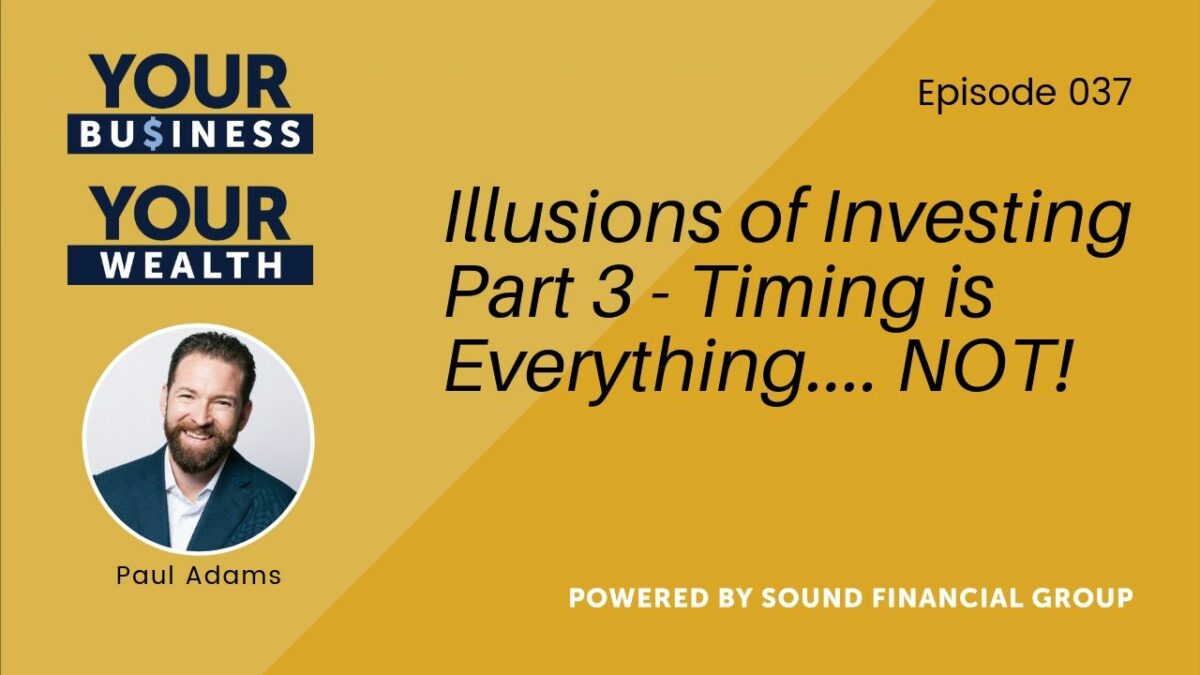Podcast Episode 37: Illusions of Investing Part 3 – Timing is Everything….Not
LISTEN HERE
EPISODE SUMMARY
Paul Adams is back with another myth-busting podcast session. This episode is part 3 of 6 on investing illusions. Can you time the market? Do you know when is the best time to buy-in or sell-out? Chances are you’ll lose more money trying to play the market than if you simply stuck with it. So, why are major publications trying to constantly have you move your money out or in? It boils down to advertisers! Find out more about this illusion on this week’s podcast.
WHAT WAS COVERED
- 02:25 – Let’s look at the performance history of the market.
- 03:00 – If you bought the S&P 500 in 1984 and sold it in 2013, that index would have given you a 11.1% return.
- 03:35 – Your average investor in equity-based mutual funds does about a 3.69% return.
- 05:00 – Paul gives a quick example of how big of a difference 11.1% is compared to 3.69%.
- 06:30 – Between 1993 to 2013, your rate of return would have been 8.6%, if you stayed in the market during the ups and downs. If you tried to ‘market time’ it to your advantage, you would have had 6.45% rate
- 10:00 – Why is it that major magazines and financial TV channels want you to have your money on the move instead of riding the market’s waves?
- 11:35 – Every time you move your money, an advertiser benefits.
- 12:15 – Paul talks about a Playboy Playmate who appeared on national news for being a day trader.
- 13:25 – What’s on TV is just for entertainment, not for education.
- 15:35 – We can not predict the future.
- 17:00 – So few people are really able to get out of the market at the right time and get back into the market at the right time.
- 17:15 – Look out for part 4 on investing illusions!
TWEETABLES
SHARE THE SHOW
Did you enjoy the show? We would love it if you subscribed today and left us a 5-star review!
- Click this link – Sound Financial Bites
- Click on the ‘Subscribe’ button below the artwork
- Go to the ‘Ratings and Reviews’ section
- Click on ‘Write a Review’
RELATED LINKS
MUSIC CREDITS
“Legends Are Made” Copyright 2017. Music, arrangement and lyrics by Sam Tinnesz, Savage Youth Music Publishing SESAC and Matt Bronleewe, UNSECRET Songs SESAC
EPISODE TRANSCRIPT – FORMATTED PDF
EPISODE TRANSCRIPT – ORIGINAL TEXT
Hello. Paul Adams here. Welcome to Sound Financial Bites, where we help you with bite-sized pieces of financial and life knowledge to help you design and build a good life.
Hello and welcome to Sound Financial Bites. My name is Paul Adams, President and CEO of Sound Financial Group. It’s great to have you with us today. Today, we’re going to be talking about Part III in a six part series around the illusions of investing. Now, we got five major illusions which we’re taking each one of our podcast in covering one of the illusions. Then part six is what can we do about these illusions to see through them and take appropriate action. We’ve talked first about the idea of stock picking that there are no magic managers out there that can consistently and predictably outperform the market, which also kind of proves out that we as individuals are not likely be able to do that either. Then we talked about track record investing that we would think — well, maybe not all of the asset managers could do but surely those who have done well in the past, good market time and do well. That’s proven not to be the case. We went through that in our last podcast.
Here in Part III, we’re going to talk about market timing. Can I move my money in and out of the market in an attempt to be able to avoid the downturns and catch all of the up swings? But before we get into our topic today, it’s just great having all of you here. What I hope we’re able to do on this podcast is help you design and build a good life. When does that happen? Well, designing and building a good life is both about financially how we might like our life structured, but it’s also about how we want our life itself structured. A big part of designing and building a good life is going to be not worrying about money. One of the biggest ways to not worry about anything or be concerned about any particular area of life whether that’s your health or your marriage or your parenting is to dig in and learn more about it. So, I just want to acknowledge all of you for getting on the podcast today and taking some of your time to be able to absorb new information to learn.
Let’s get into this topic around market timing. What a lot of people don’t realize is that if you look at the history of performance to the market, there’s going to be touches of analytical things here so hang with me. If you look at just what the Standards and Poor’s 500 index is — Now, if you’re not familiar with indexes, the Standards and Poor’s 500 index is a large wide index. It holds about 500 different stocks and those stocks are large cap growth companies here in the United States.
It’s a pretty good indicator of markets overall. People point to it quite a bit as how the “economy” is doing. Let’s say all you did because you have no investment manager, nobody helping you, what you did is you just bought the S&P 500. In buying the S&P 500, you bought it 1984, you sold in in 2013. That index would’ve done 11.1% over that horizon of time. Now, there is a large mutual fund research company called Dalbar, and what Dalbar does is all kinds of research for the industry at times and for consumers at times to say hey what’s really happening out there. What’s surprising is your average investor in equity based mutual funds, meaning stocks. Or if you’re not familiar, equities translate to stocks, stock – based mutual funds did 3.69%. So, the S&P 500 at 11.1, the Dalbar average equity investor did 3.690. The real bad news about that is, 3.69 was the average investor, meaning half or someone out did worst than the 3.69 and it’s largely because and what they attributed to is behavior. Then what people tend to do is move money in the market and move money out of the market at times when they shouldn’t. This is happening equally with those people that have advisors. People with advisors tend to do a little bit better but it’s also happening with a great deal of people that have no advisor because they engage in the market and get out perhaps when they shouldn’t. In CPI over that same period of time, the Consumer Price Index, the measure of inflation, was 2.8%, so you didn’t even outperform the inflation by 1%. If you had the returns of the average equity investor from ‘84 to 2013 or for 30 years. That’s a lot of money. As a matter of fact, just for fun, on my computer here I’m pulling up a calculator just what would be the difference if we had $100,000 and we’re not counting any taxes or fees, but I want to give you an idea of how big of a difference it is 11.1% versus 3.69%. We’re just going to say $100,000 invested 30 years ago, that did 11.1% — and I’m sliding my calculator out to a total of 30 years — then, if we did the same thing, that will be 2.35 million. But, if the same person — so with $100,000 at 2.35 million if they were in the S&P 500 index over that entire horizon of time, not looking at taxes or inflation for now, just to total differential in that rate of return versus 3.69, the person would’ve had $296,000. So, 2.35 million versus $296,000. That’s a big big gap. That’s the kind of thing people don’t talk about all the time because that behavior gap, and in fact many times the financial advisors tend not to talk about it. The reason that they may not talk about it is they are making some of the same recommendations to their clients. The advisors themselves are saying what we should do is move you in it. Now is a good time to get in, now is a good time to get out, and the problems that that creates.
I’m going to give a different example here. If we just took 1993 through 2013, so this is July mid-year 1993 through mid-year 2013. There was a total over that period of time of 5,040 trading days. So just 5,000 days the stock market was open and stocks were trading. Over that period of time the market — and that includes the mortgage crash, it includes the tech bubble, the burst. Your rate of return if you just held the S&P 500 would’ve been 8.66% but if you missed — because anytime we are out of the market, we risk missing some of the best days which oftentimes follow the big down days, so for out of the market when those days occur, now we put ourselves in a position where if we missed just the best five days. We go from 8.6 to 6.45%, if you missed the 20 bested days worth 2.5%.
Now, I want to talk here for a moment about the way people talk about money. You see everybody knows someone. You’ve been on a wine tasting, you’ve been in a dinner party, or you’ve been in a friend’s house and while you’ve been there, they’re talking about what happened in 2008. They say something like I got out totally. I was not in the market, I sold everything on September 15th right before the crash 2008, saved myself a 40% downturn of the S&P 500, and you’re one of those people. The question that would be confronting, I’m not saying you should ask this question, this will be a rude question to ask, but to say “when did you get back in?” Because truth be told, you had to get back in March of 2009. If you could think back to that, about what was going through our heads in March of 2009 about the market? People are threatening that you are going to be off the dollar and all kinds of stuff. If you had 5 million dollars, you got out of the market in September of 2008 and you got all back in march 2009, those two behaviours don’t mix. Somebody fearful enough to get totally out is not likely to get back in. If you waited just like a year to get back in, then you only avoided about a 10% downturn. You really didn’t avoid that much.
You can play with this. Go to Google Finance, search this. Look at that period of time from that mid-September to a couple of years after, and you’ll start to see how quickly the S&P 500 came back. That’s not even a globally diversified academically allocated portfolio, that is purely S&P 500. Typically, more volatile and yet you still would have lost if you didn’t get totally back in. That’s what people miss. Then, when we try to learn more about money, when I see people working to be responsible, it’s not uncommon for me to see them trying to be more responsible by listening to the media, by reading the paper, by watching, you know insert business channel here.
Here’s the problem, every single one of those mediums that’s pushing information to us, the current that we’re swept up in wants you to have your money on a move. Now, why is that? Why is it that a major news network would want you to have your money on the move? Why is it that a major magazine would want you to have your money on the move? Why is it that the major newspapers or the AM Radio wants your money on the move? It’s easy. You’re not their customer. You are not the customer of any of those entities. Do you know how I know? Because if you get a subscription to some financial magazine, you are going to see it doesn’t cost very much. In fact, it’s incredibly inexpensive. It’s less expensive. Have you ever gone to Kinkos and try to print some colored pages? What they charge for it or get a colored book printed or a color magazine printed? They are expensive even at huge scale, they are expensive. So, why is it I can buy that magazine for as little as a dollar a month? Here’s why. What they want — I as the reader of that magazine, I am the product that they are selling to somebody else. They are selling you to their advertisers. So, who advertises these publications? Pretty easy. Watch your news channel. Watch the AM radio, listen to it. It’s always somebody saying instead of being where you are, you should move your money to here. Instead of doing this, you should do that. The networks get the chance to better satisfy their people for two reasons. One, people are glued to the screen because there is always some dooms, they have something falling apart and periodically in times of boom, there will be people on there talking about greed and how people are killing it, like people are doing a great job amazing rates of return, you should get in on this. Again, another move to get you to move your money. Everytime we talk about getting people to move their money, that works out better for an advertiser.
One of my favorites is I saw — to show how the network is working to just get our eyeballs glued to the screen, the networks, the magazines, all that, their job is not to have you have financial success, their job — or the book authors — their job is to engage your eyeballs, right. On Fox news, it just happens to be Fox news, you can Google it, the title is playboy bunny turned day trader on riding wild market swings. Just Google that and what’s going to come up is this video of this woman who is pretty articulate, well – spoken, but she is a day trader. She’s a day trader and she’s formally a playboy bunny so of course it’s like well I’m going to change channel but at least I’ll stick around and watch to see what she’s got to say about the market because it’s unique and novel so we’ll watch. I’ll be darn, she gets through the whole interview. Almost near the end of the interview, the interviewer goes “Hey, how long have you been doing this?” She was “Oh since April. I don’t know. It’s like mid – june.” She’d only been doing it since April. She’s on a national news network telling people what they should do or the kinds of strategies they should be in when doing online trading. It turns out she’d been doing it for less than three months. I got nothing about her being a playboy bunny other than the fact that obviously the news network wanted to use that to keep our eyeballs glued to it, but the interesting thing is and the thing that’s problematic, is the way that they were so willing to use novelty to engage our eyeballs, not academic scholarship, not math. What they wanted is they wanted just eyeballs glued long enough for the next commercial round which was not surprising that there was like a Scottrade commercial or an E-Trade commercial after that because they want “Oh that look like that wasn’t too hard. I guess i could go to it.” They hope you go online and open that account immediately thereafter.
You see, when we go up against — there’s two things we’re up against. We’re trying to market time. One, we’re up against just all the unknowns of the world. All the unknowns of the world that things can happen, national disasters occur, companies get wiped out for reasons we can’t anticipate. Economy’s have problems that we can’t fully anticipate and so people try to get their money in and out of market. Too often, it costs them tremendous amounts of money and they don’t realize it. Here’s what I want you to think about. The person that got out of the market at the end of 2008 and is beating on their chest bragging about how well they did in getting out of the market. If you go online to our YouTube, you’re going to see a video called After the Crash. Watch that video. That video really articulates for somebody how much they lost because they are still beating on their chest at the wine tasting about the lost they avoided, the downside volatility that they avoided and literally sacrificed all of the upside that their money would’ve grown many multiples since the bottom of 2008 if they would’ve stayed as a disciplined investor.
That’s what we have to be able to do, stay a disciplined investor in the midst of all the things that happen around us in the world to tell us not to be disciplined investors.
We’re going to have more episodes on that but let me just wrap here today on this third illusion of market timing, is that you can’t do it. It’s not you. There’s nothing wrong with you. The major market timers out there can’t do it. Not that no one’s ever going to be able to do it, somebody will. Based upon the illusion number two on our last podcast, they are going to claim credit like they did it and they can do it again, but we have no academic evidence that that’s possible. That it’s easily predictable who did it in the past and who will do it again. We can’t be participating in the market timing nor should we be working with an advisor that’s going to have us in this market timing mentality, there’s no academic evidence that works or having an asset manager that we’re using who’s making some promise. It may be a very flowery story about how they do it and why they do it and how they change but it’s just not real.
One last word here. There is something out there talked about called tactical asset allocation, that is — what we’re going to do is move into different sectors with your money based upon how we think that particular sector is going to do. I got news for you all, that is market timing in disguise. Market timing in disguise because they are saying here is this pie chart of all these different investments and we’re going to change how we allocate among the different types of investing small cap, mid cap, large cap. We’re going to change our asset class allocation to get us sector and that’s just tactical asset allocation so somebody’s still guessing, somebody’s still speculating and gambling. We don’t want to do that. We are going to talk about the solution here in Part VI but that is kind of all I got for you on this idea of market timing. Can we get our money in and out? Somebody is going to get it out at the right time, they are going to brag about it. But odds are and very very few people get out and they get back in enough to have actually benefitted from getting out before the downturn.
We look forward to seeing you in Part IV. I am so happy to be able to bring all of you this. I hope what it’s going to allow you to do is not just design and build a good life for you but part of designing and building a good life is shutting off all the influence of the things that stop us from being able to design a good life and build a good life. I look forward to seeing you all on Part V.
Hi, Paul Adams here. I want to acknowledge you for taking the time to invest in yourself by listening to our podcast. Not everybody does that, and out of my commitment to you, I will take just a few of our podcast listeners between each of our episodes and spend time with them one-on-one. And if you think you’d like some of that one-on-one time to learn more about our process, our philosophy, or whether or not we’d be a fit to work together, just email [email protected]. That’s [email protected], and I’ll be more than honored to take that time with you.
You can also go to our website: www.sfgwa.com, download the first three chapters of my book, see upcoming in person events that we have, or listen to past episodes. You can also go to our Facebook page and engage us there, our LinkedIn, and send us questions for upcoming podcasts. You might hear one of your comments or questions on a future podcast. For our full disclosure, you can check the description on this podcast or on the podcast series, or go to our website. Have a great day.
———————————————————————————————————————————
This Material is Intended for General Public Use. By providing this material, we are not undertaking to provide investment advice for any specific individual or situation, or to otherwise act in a fiduciary capacity. Please contact one of our financial professionals for guidance and information specific to your individual situation.
Sound Financial Inc. dba Sound Financial Group is a registered investment adviser. Information presented is for educational purposes only and does not intend to make an offer or solicitation for the sale or purchase of any specific securities, investments, or investment strategies. Investments involve risk and, unless otherwise stated, are not guaranteed. Be sure to first consult with a qualified financial adviser and/or tax professional before implementing any strategy discussed herein. Past performance is not indicative of future performance. Insurance products and services are offered and sold through Sound Financial Inc. dba Sound Financial Group and individually licensed and appointed agents in all appropriate jurisdictions.
This podcast is meant for general informational purposes and is not to be construed as tax, legal, or investment advice. You should consult a financial professional regarding your individual situation. Guest speakers are not affiliated with Sound Financial Inc. dba Sound Financial Group unless otherwise stated, and their opinions are their own. Opinions, estimates, forecasts, and statements of financial market trends are based on current market conditions and are subject to change without notice. Past performance is not a guarantee of future results.
Each week, the Your Business Your Wealth podcast helps you Design and Build a Good Life™. No one has a Good Life by default, only by design. Visit us here for more details:
yourbusinessyourwealth.com
© 2019 Sound Financial Inc. yourbusinessyourwealth.com
PRODUCTION CREDITS
Podcast production and marketing by FullCast
Recorded using Switcher Studio: [email protected]










